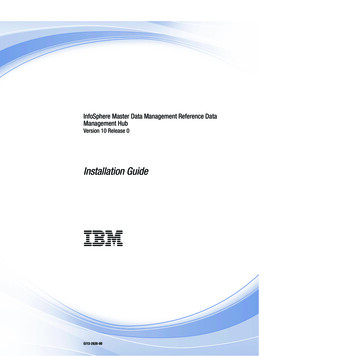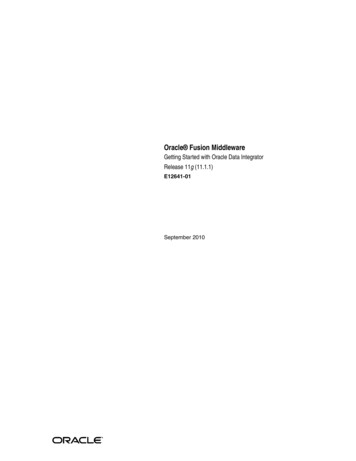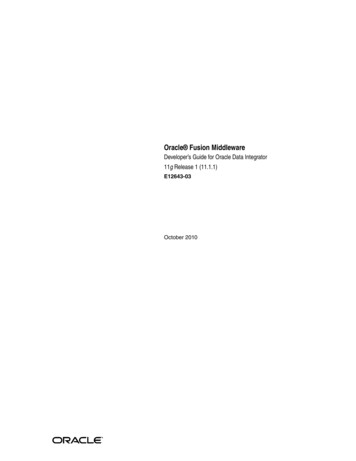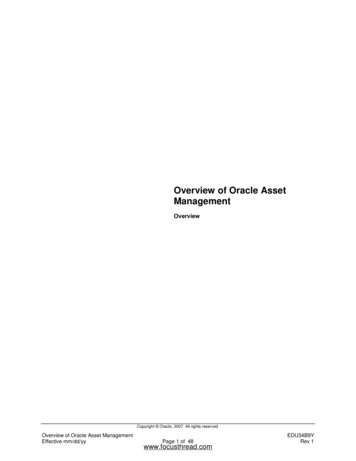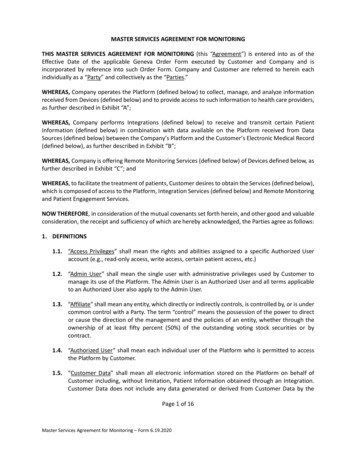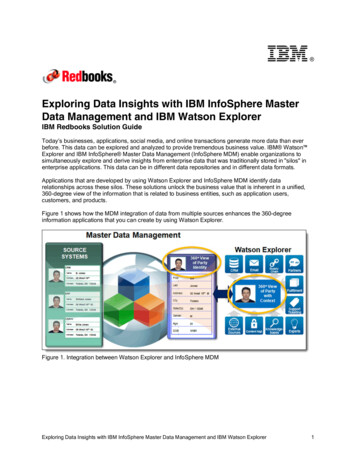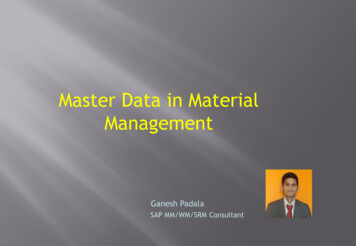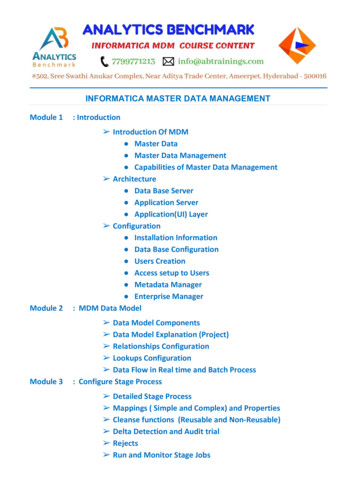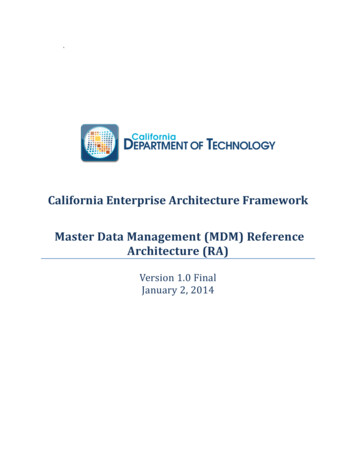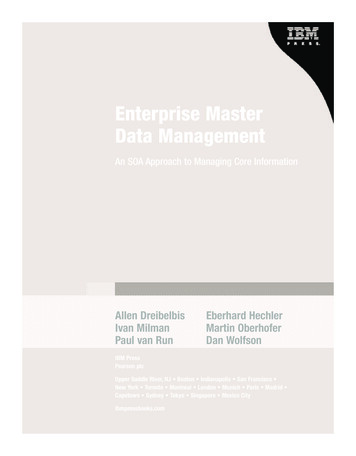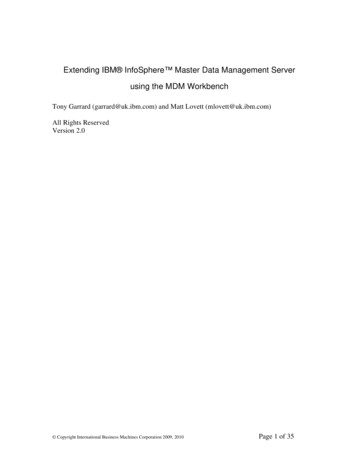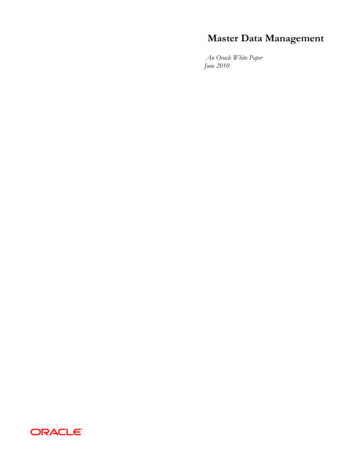
Transcription
Master Data ManagementAn Oracle White PaperJune 2010
Master Data ManagementIntroduction . 1Overview. 2Enterprise data . 4Transactional Data . 4Operational MDM . 5Analytical Data . 5Analytical MDM . 5Master Data . 5Enterprise MDM . 6Information Architecture . 6Operational Applications . 6Enterprise Application Integration (EAI) . 7Service Oriented Architecture (SOA) . 7The Data Quality Problem. 7Analytical Systems. 8Enterprise Data Warehousing (EDW) and Data Marts . 8Extraction, Transformation, and Loading (ETL). 9Business Intelligence (BI). 9The Data Quality Problem. 9Ideal Information Architecture . 10Oracle Information Architecture . 11Master Data Management Processes . 13Profile . 14Consolidate . 15Govern . 15Share . 15Leverage . 16Oracle MDM High Level Architecture . 16MDM Platform Layer . 17Application Integration Services . 17Enterprise Service Bus . 17Business Process Orchestration Services . 17Business Rules . 18Event-Driven Services . 19Identity Management. 19Web Services Management. 19Analytic Services . 20Enterprise Performance Management . 20Data Warehousing . 20Business Intelligence . 21Master Data Managementii
Publishing Services . 21Data Migration Services . 21High Availability and Scalability . 22Real Application Clusters . 22Mixed Workloads . 22Exadata . 22Application Integration Architecture . 23AIA Layers . 23Common Object Methodology . 24MDM Foundation Packs . 24MDM Process Integration Packs . 24MDM Aware Applications. 25Composite Application Development . 25Oracle Data Quality Services . 25Oracle Customer Data Quality Servers . 27Product Data Quality . 29End-To-End Data Quality . 31Application Development Environment . 32MDM Applications Layer . 32MDM Pillars . 32Oracle Customer Hub . 33Customer Data Model . 34Consolidate. 35Cleanse . 36Govern . 36Share . 38Business Benefits . 39Product Hub . 39Import Workbench . 40Catalog Administration . 41New Product Introduction . 41Product Data Synchronization . 41Oracle Site Hub . 42Golden Record for Site Data. 43Application Integration . 43Effective Site Analysis and Google Integration . 43Oracle Supplier Hub. 45Consolidate. 45Cleanse . 46Govern . 46Share . 46Supplier Lifecycle Management . 46Business Benefits . 46Oracle Hyperion Data Relationship Management . 47Automated Attribute Management . 48Best-of-Breed Hierarchy Management . 49Integration with Operational and Workflow Systems . 49Import, Blend, and Export to Synchronize Master Data . 49Versioning and Modeling Capabilities to Improve Analysis. 50Master Data Managementiii
MDM Data Governance and Industries Layer . 50MDM Industry Verticalization . 50Higher Education Constituent Hub. 50Product Hub for Retail . 51Product Hub for Communications . 51Data Governance . 52Data Watch and Repair for MDM . 53MDM Implementation Best Practices . 54Build vs Buy . 55Conclusion . 56Master Data Managementiv
Master Data ManagementINTRODUCTIONMany organizations are not realizing theanticipated ROI in their existingapplications.Oracle MDM helps organizations realizethe return on existing and new applicationinvestments.Fragmented inconsistent Product data slows time-to-market, creates supply chaininefficiencies, results in weaker than expected market penetration, and drives up thecost of compliance. Fragmented inconsistent Customer data hides revenuerecognition, introduces risk, creates sales inefficiencies, and results in misguidedmarketing campaigns and lost customer loyalty 1 . Fragmented and inconsistentSupplier data reduces supply chain efficiencies, negatively impacts spend controlinitiatives, and increases the risk of supplier exceptions. “Product”, “Customer”,and “Supplier” are only three of a large number of key business entities we refer toas Master Data.Master Data is the critical business information supporting the transactional andanalytical operations of the enterprise. Master Data Management (MDM) is acombination of applications and technologies that consolidates, cleans, andaugments this corporate master data, and synchronizes it with all applications,business processes, and analytical tools. This results in significant improvements inoperational efficiency, reporting, and fact based decision-making.Over the last several decades, IT landscapes have grown into complex arrays ofdifferent systems, applications, and technologies. This fragmented environment hascreated significant data problems. These data problems are breaking businessprocesses; impeding Customer Relationship Management (CRM), EnterpriseResource Planning (ERP), and Supply Chain Management (SCM) initiatives;corrupting analytics; and costing corporations billions of dollars a year. MDMattacks the enterprise data quality problem at its source on the operational side ofthe business. This is done in a coordinated fashion with the data warehousing /analytical side of the business. The combined approach is proving itself to be verysuccessful in leading companies around the world.“Through 2010, 70 percent of Fortune 1000organizations will apply MDM programs toensure the accuracy and integrity ofcommonly shared business information forcompliance, operational efficiency andcompetitive differentiation purposes (0.7probability).”GartnerThis paper will discuss what it means to ‘manage’ master data and outlines Oracle’sMDM solution 2 . Oracle’s technology components are ideal for building master datamanagement systems, and Oracle’s pre-built MDM solutions for key master dataobjects such as Product, Customer, Supplier, Site, and Financial data can bring realbusiness value in a fraction of the time it takes to build from scratch. Oracle’sMDM portfolio also includes tools that directly support data governance within themaster data stores. What’s more, Oracle MDM utilizes Oracle’s ApplicationIntegration Architecture to create MDM Aware Applications 3 and integrate thehigh quality authoritative master data into the IT landscape. This fusion ofCustomer Data Integration – Reaching a Single Version of the Truth, Jill Dyche, Evan Levy Wiley & Sons,20062 Oracle Master Data Management, an Oracle Data Sheet, URL3 MDM Aware Applications, an Oracle Whitepaper, URL1
applications and technology creates a solution superior to other MDM offerings onthe market.OVERVIEWHigh quality customer information wascritically important for Areva’s deploymentof major new application suites, includingSCM and CRM. Oracle Customer Hubprovided the unique customer databasethat can be shared by all applicationsmanaging customer data and the criticaldata quality tools needed to increase ourcustomer knowledge. With OracleCustomer Hub at the center of the Areva ITlandscape, customer data is collected fromall relevant applications, harmonized,merged, enriched with D&B data, andpublished to operational and analyticalsystems. ROI has been measured at 38%over 4 years with a 37 month payback.Florence Legacy, Project ManagerBruno Billy, Data ManagerAreva T&DHow do you get from a thousand points of data entry to a single view of thebusiness? This is the challenge that has faced companies for many years. ServiceOriented Architecture (SOA) is helping to automate business processes acrossdisparate applications, but the data fragmentation remains. Modern businessanalytics on top of terabyte sized data warehouses are producing ever more relevantand actionable information for decision makers, but the data sources remainfragmented and inconsistent. These data quality problems continue to impactoperational efficiency and reporting accuracy. Master Data Management is the key.It fixes the data quality problem on the operational side of the business andaugments and operationalizes the data warehouse on the analytical side of thebusiness. In this paper, we will explore the central role of MDM as part of acomplete information management solution.Master Data Management has two architectural components: The technology to profile, consolidate and synchronize the master dataacross the enterprise The applications to manage, cleanse, and enrich the structured andunstructured master dataMDM must seamlessly integrate with modern Service Oriented Architectures inorder to manage the master data across the many systems that are responsible fordata entry, and bring the clean corporate master data to the applications andprocesses that run the business.“The master data management systemgave us a single, integrated view of ourcustomers, partners, and suppliers. Theinformation helps us run our businessmore effectively and ensures we makesound decisions.”Kim Hyoung-soo, Section ChiefProcess Innovation Team, MDM SectionHanjin ShippingMDM becomes the central source for accurate fully cross-referenced real timemaster data. It must seamlessly integrate with data warehouses, EnterprisePerformance Management (EPM) applications, and all Business Intelligence (BI)systems, designed to bring the right information in the right form to the rightperson at the right time.In addition to supporting and augmenting SOA and BI systems, the MDMapplications must support data governance. Data Governance is a business processfor defining the data definitions, standards, access rights, quality rules. MDMexecutes these rules. MDM enables strong data controls across the enterprise.In order to successfully manage the master data, support corporate governance, andaugment SOA and BI systems, the MDM applications must have the followingcharacteristics: A flexible, extensible and open data model to hold the master data and allneeded attributes (both structured and unstructured). In addition, the datamodel must be application neutral, yet support OLTP workloads anddirectly connected applications. A metadata management capability for items such as business entitymatrixed relationships and hierarchies.Master Data Management2
A source system management capability to fully cross-reference businessobjects and to satisfy seemingly conflicting data ownership requirements. A data quality function that can find and eliminate duplicate data whileinsuring correct data attribute survivorship. hA data quality interface to assist with preventing new errors fromentering the system even when data entry is outside the MDM applicationitself. A continuing data cleansing function to keep the data up to date. An internal triggering mechanism to create and deploy change informationto all connected systems. A comprehensive data security system to control and monitor data access,update rights, and maintain change history. A user interface to support casual users and data stewards. A data migration management capability to insure consistency as datamoves across the real time enterprise. A business intelligence structure to support profiling, compliance, andbusiness performance indicators. A single platform to manage all master data objects in order to prevent theproliferation of new silos of information on top of the existingfragmentation problem. An analytical foundation for directly analyzing master data. A highly available and scalable platform for mission critical data accessunder heavy mixed workloads.Oracle’s market leading MDM solutions have all of these characteristics. With thebroadest set of operational and analytical MDM applications in the industry, OracleMDM is designed to support Governance, Risk mitigation, and Compliance (GRC)by eliminating inconsistencies in the core business data across applications andenabling strong process controls on a centrally managed master data store.Master Data Management3
This paper examines: the nature of master data; MDM’s central role in SOA and BIsystems; the Oracle MDM Architecture; key MDM processes of profiling,consolidating, managing, synchronizing, and leveraging master data and how theOracle MDM solution supports these processes; and Oracle’s portfolio of pre-builtmaster data management solutions. Finally, this paper discusses build vs. buytradeoffs given the power and flexibility in the Oracle MDM architecture and outof-the-box capabilities of the pre-built and pre-connected MDM Hubs.ENTERPRISE DATAAn enterprise has three kinds of actual business data: Transactional, Analytical, andMaster. Transactional data supports the applications. Analytical data supportsdecision-making. Master data represents the business objects upon whichtransactions are done and the dimensions around which analysis is accomplished.Types of Data in the aAnalyticalData Describes an Enterprise’sOperational State Describes an Enterprise’sBusiness Entities Describes an Enterprise’sPerformanceAs data is moved and manipulated, information about where it came from, whatchanges it went through, etc. represents a fourth kind of enterprise data calledmetadata (data about the data). Though not a prime focus of this paper, the keyrole metadata plays in the broader information management space and how itrelates directly to MDM is described.Transactio
Feb 07, 2003 · MDM is designed to support Governance, Risk mitigation, and Compliance (GRC) by eliminating inconsistencies in the core business data across applications and enabling strong process controls on a cent

